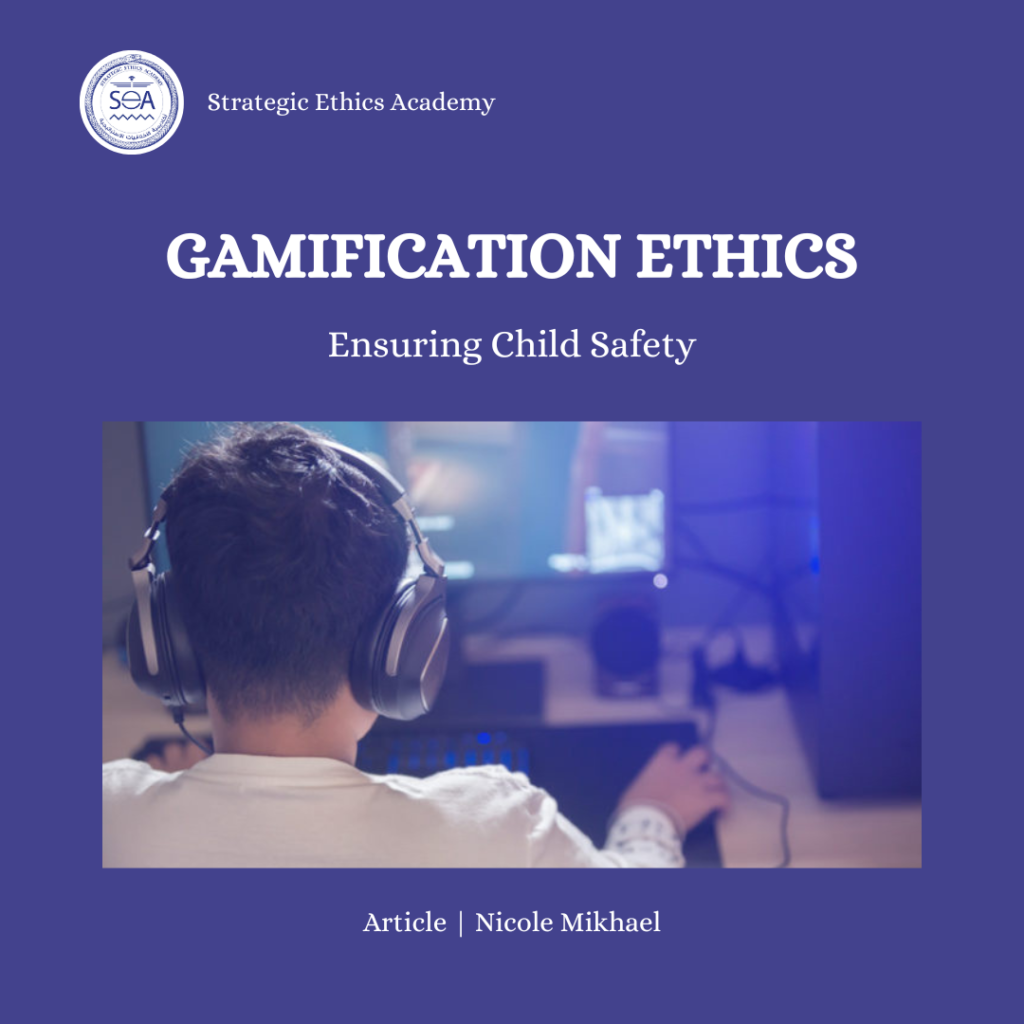
Article | Nicole Mikhael
With the advancement of technology and the proliferation of electronic games and mobile applications across various fields, games have increasingly played an effective role in educational and training contexts, enhancing children’s cognitive abilities, comprehension, and creative skills. With well-designed games, they can serve as a powerful tool for teaching children new concepts and achieving enjoyable, engaging learning experiences. These games can capture a child’s attention, motivate them to learn, and encourage goal attainment. However, educational objectives must be clear and specific. As the use of electronic games in children’s lives grows, the question of the ethics of gamification and the ethical framework of the technologies used in developing these games to ensure children’s safety emerges.
Understanding the technical aspect of electronic game development requires recognizing how to enhance user interaction by integrating game design elements into educational or developmental contexts aimed at modifying children’s behaviors and helping them adopt moderate and ethical behavior. Initially, gamification techniques aimed to leverage the natural desire for communication, learning, self-expression, competition, achievement, and status. Over the past twenty-five years, there has been a significant rise in the use of electronic games in educational and professional environments. Whether in e-learning platforms or corporate training programs, electronic games have proven effective in enhancing knowledge and interaction among people. A study at «MIT Sloan» found that innovative games helped participants generate more and better ideas. By applying game elements such as points, badges, and leaderboards, educational games have been transformed into more immersive and enjoyable experiences, attracting a wide range of learners across different age groups and industry platforms.
On the other hand, ethical considerations in game design require a multidimensional approach to developing age-appropriate content with educational value aligned with developmental needs. It is also essential to design reward systems that encourage positive behaviors without promoting addiction, while adhering to legal regulations and implementing content monitoring mechanisms to ensure it is appropriate and safe for children. For instance, «YouTube Kids» has employed content filters and specialized reviewers to maintain a safe environment for young viewers. In this context, it is crucial to have effective systems to moderate the content children are exposed to by developing technologies that filter out inappropriate materials. Some games may contain inappropriate or violent content that could negatively impact children’s behavior and their view of the world. Additionally, it is necessary to create technologies aimed at detecting harmful interactions to protect users from cyberbullying, harassment, and other harmful behaviors. Therefore, clear policies are essential to protect children from exploitative advertisements or inappropriate messages, considering their impact on behavior and development. Game developers must adhere to the ethical codes established by relevant electronic engineering bodies, such as the «Association for Computing Machinery» (ACM), the «Institute of Electrical and Electronics Engineers» (IEEE), and others that provide guidelines for maintaining integrity, accountability, and privacy in technology design and implementation.
In the same vein, compliance with data protection regulations such as the «General Data Protection Regulation» (GDPR) and the «Children’s Online Privacy Protection Act» (COPPA) is crucial, as they impose strict controls on data collection, processing, and storage, especially for children. Children’s privacy is a critical issue in the digital age that requires attention, posing several challenges and questions for innovators, such as: How can data be collected from children without compromising their privacy? What safeguards must be in place to prevent misuse of personal information? Some games require personal information from users, which may be sensitive. Thus, controls must be established to protect children’s data and prevent its use for commercial purposes, similar to the «COPPA» guidelines in the U.S., which mandate strict rules for online services aimed at children under 13. Technically, it is also important to develop robust algorithms that play a vital role in maintaining data security and privacy within the framework of ethical gamification, as well as employing encryption mechanisms, data minimization, and continuous feedback and regular ethical reviews to assess the impact of gamification elements.
Furthermore, innovations aimed at children should be inclusive, making them accessible to all children regardless of social status, economic ability, or geographical location. Electronic game designers should consider diverse user needs by creating culturally and economically varied content that can be used on low-cost devices or offline, ensuring all children can access these games and benefit from their educational or developmental content. For instance, such games and applications could include features like voice readers, adjustable text sizes, and alternative input methods for children with special needs. To promote inclusivity, the «Sesame Workshop» launched the “Seeing the Greatness in All Children” initiative by featuring characters with autism in “Sesame Street” content. Similarly, UNESCO’s “AI for Good” initiative aims to create unbiased AI tools for education, including those for children.
Given the surrounding risks and precautions, there is an urgent need to encourage parents and teachers to play an active role in monitoring and guiding children to ensure they benefit from games in positive and safe ways. They should direct children towards games that promote learning and skill development. Family tech startups, such as «Famtech», have recognized this challenge and developed parental control and monitoring tools to address it, allowing parents to set screen time limits, block inappropriate content, and monitor online activities. For example, apps like Bark analyze text messages, social media, and emails to detect potential risks such as cyberbullying or explicit content. With these tools, parents can feel reassured about their children’s online safety. In conclusion, games are a powerful tool that can positively impact children’s learning and development; however, they must be handled with caution and responsibility, implementing clear and comprehensible privacy policies for both parents and children, along with documented parental consent protocols and other policies and technologies that are vital for protecting young users’ interests to ensure they have the best possible experience in a safe and beneficial manner.
Nicole Mikhael
IT Researcher
Technical License in Information Technology
